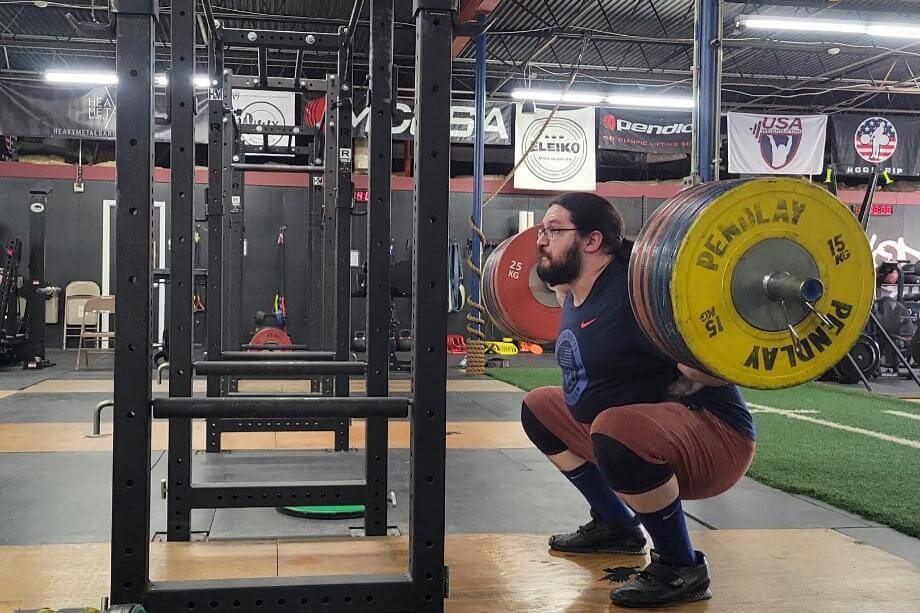We test and review fitness products based on an independent, multi-point methodology. If you use our links to purchase something, we may earn a commission. Read our disclosures.
Most fitness enthusiasts don’t mind an upper-body workout chock full of bench presses and biceps curls. Even dropping to the mat for some core strength training is in bounds.
Yet, when the prospect of “leg day” rears its ugly head, the moans and groans are louder than a barbell crashing down after a push jerk PR.
Why are we so averse to lower-body workouts?
Having lower body strength is super useful, on the playing field, in the weight room, and in everyday life, too. So, let’s trade those biceps curls for leg curls, those shoulder raises for calf raises, and give some much-needed attention to the muscle groups down south!
Lower-Body Anatomy
Commonly referred to as “the legs,” the main lower body muscle groups are as follows.
Glutes
Your butt, your behind, your derriere— whatever you wanna call it!
Your gluteal muscles1 consist of the gluteus maximus, gluteus medius, and gluteus minimus. Many people train the glutes for aesthetics, but glute training also improves posture and promotes more efficient biomechanics along the posterior chain.
Quadriceps
Believe it or not, the quadriceps2 are one of the largest muscle groups in the whole body, consisting of the rectus femoris, vastus lateralis, vastus medialis, and vastus intermedius.
Activities like walking, running, and jumping are made possible through the hard work of your quads, which work together to extend and stabilize the knee.
Hamstrings
Located on the back of your thighs, the hamstring muscles3 are made up of the biceps femoris, semitendinosus, and semimembranosus. They’re responsible for basic stuff like standing in place, but they also assist in explosive movements like snatches, kettlebell swings, and box jumps.
Calves and Shins
The calf muscles4 are the “odd man out” of the bunch, since most lower body exercises focus on the other muscle groups listed above. Nonetheless, the gastrocnemius and soleus are very important muscles for keeping proper posture and facilitating proper walking form.
A 2014 review5 published in Foot and Ankle Clinics stated the calf muscle group is “remarkable in that it has very low energy consumption and very high mechanical efficacy.” Although small by comparison, this muscle group certainly is mighty!
RELATED: Calf Exercises
Best Lower-Body Exercises
To maximize the effect of our lower body workout, we’re employing the three essential movement patterns that will provide activation throughout the lower body.
We’re talking squats, lunges, and hip hinge movements, so that every muscle group gets activation during this incredible leg workout.
RELATED: Dumbbell Leg Workout
Fill your water bottle, get in a warm-up, and let’s get to work!
1. Barbell Back Squats
Why it’s great: The barbell back squat is royalty as far as lifts go. It’s a highly functional movement that targets numerous muscles in your lower body, namely the lower back, glutes, and hamstrings, to build incredible lower body strength and endurance.
RELATED: What Muscles Do Squats Work?
How to do it:
- Set a barbell on the J-hooks of a squat rack or power rack and load it to the desired weight. Then, unrack the bar on your upper back across your shoulders.
- Bring your hips back and bend your knees as you lower your butt as though sitting down in a chair. Keep descending until your thighs are parallel with the floor.
- Pause briefly, then push your heels into the floor to return to a standing position.
- Repeat as needed.
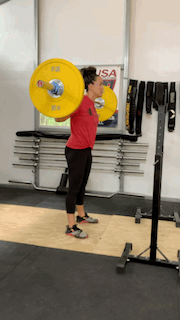
2. Barbell Front Squats
Why it’s great: The barbell front squat provides strength and hypertrophy benefits to the lower body muscles, just like the back squat, but places less strain on the lower back6.
How to do it:
- Load a barbell to the desired weight, then unrack it into the front rack position. The bar should sit across your shoulders and the top of your chest.
- Hinge forward by bringing the hips back, then bend your knees as you lower into your squat. Keep your chest tall and your elbows pointed forward as you descend.
- Push your heels into the floor to return to a standing position. Push your knees outward as you stand and bring the hips forward at the end.
- Repeat as needed.
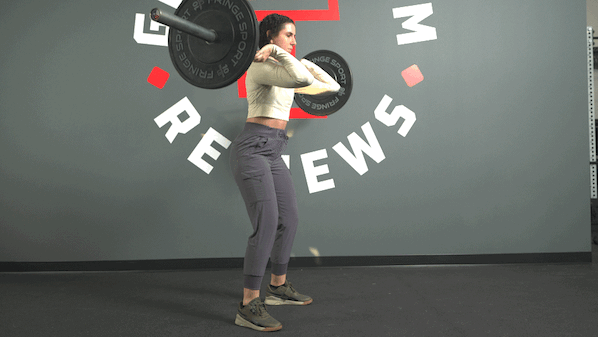
3. Bulgarian Split Squats
Why it’s great: The Bulgarian version ups the ante of the standard split squat by requiring you place your back leg on an elevated surface. This increases the challenge and improves mobility in your ankles, knees, and hips.
How to do it:
- Stand facing away from a weight bench and place one foot behind you on the bench.
- Bend your front knee, lowering yourself into a squat, until it forms a 90-degree angle.
- Drive through your front heel to return to standing.
- Repeat as needed, then switch sides and repeat the set.
RELATED: The 9 Best Quad Exercises
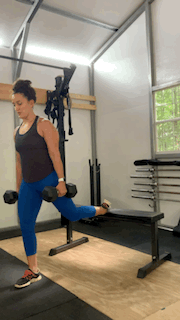
4. Walking Lunges
Why it’s great: Walking lunges, reverse lunges, forward lunges—the reason there are so many lunge variations is because they’re all great at targeting your lower body muscles. Plus, they enhance posture and balance and correct muscle imbalances.
How to do it:
- Start by standing with your feet hip-width apart.
- Step forward with your left foot, dropping the right knee until both legs form 90-degree angles.
- Pause, then push into the floor with your left foot while bringing the right foot forward. Now, shift your weight forward, while both your right and left knee form right angles.
- Continue walking until you’ve completed the desired distance or number of reps.
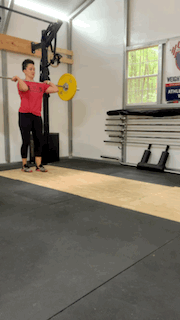
5. Barbell Hip Thrusts
Why it’s great: Hip thrusts activate your glutes big time, making them a great exercise that translates to other lifts and movements that require explosive hip movements like the clean, the snatch, and the kettlebell swing.
How to do it:
- Place a loaded barbell parallel to a weight bench, then sit perpendicular to the bench with your upper back and arms resting on top.
- Roll the barbell over your hips into the crease.
- Push your feet into the floor and your upper back into the bench as you thrust your hips toward the ceiling, squeezing your glutes at the peak position.
- Slowly return to the starting position.
- Repeat as needed.
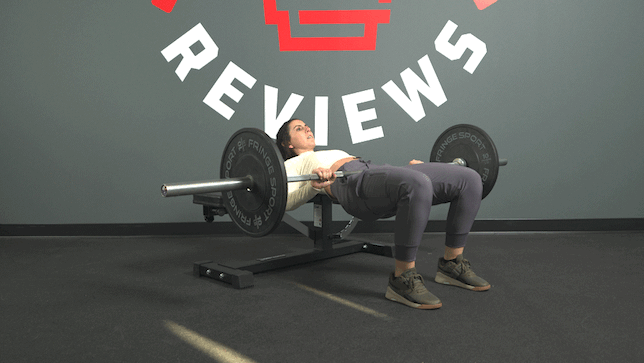
6. Glute Bridge
Why it’s great: Glute bridges improve hip mobility, build lower back stability, and, as the name would suggest, target the gluteus maximus, too.
How to do it:
- Lie down on your back with your knees bent and feet flat on the floor.
- Extend your hips and push with your feet to get your butt off the floor.
- Squeeze your glutes, then slowly come back down.
- Repeat as needed.
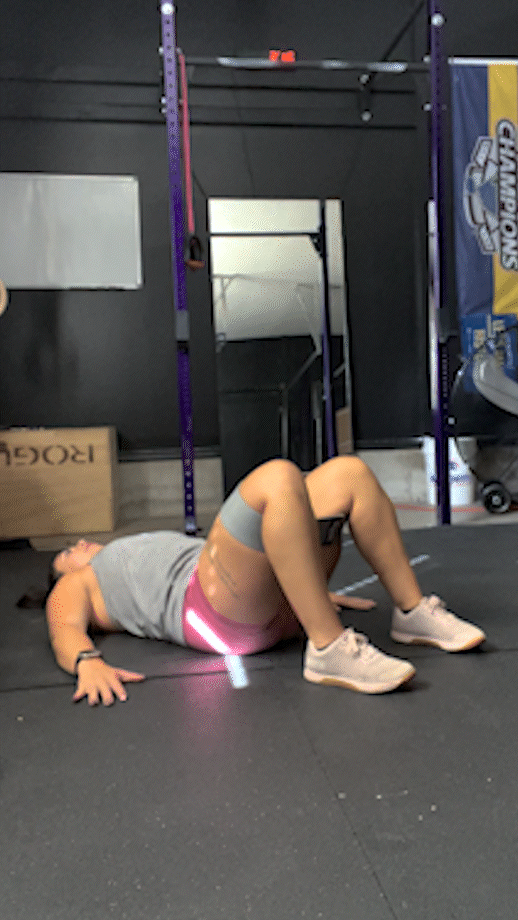
7. Banded Hip Abductions
Why it’s great: Loads of movements get your leg muscles to push and pull against resistance, but what about abduction? The banded hip abduction utilizes a resistance band to strengthen your hip abductors, which is important for good mobility, stabilization, and injury prevention.
How to do it:
- Wrap a mini band around your quads, just slightly above the knee, and lie on your side.
- With your knees vertically stacked, lift your top knee away from your bottom knee.
- You should feel this movement primarily in the glutes. Continue moving until you feel your back or core begin assisting the movement.
- Slowly return the top knee to the starting position.
- Repeat as needed, then switch sides and repeat the set.
RELATED: Best Resistance Bands for Glutes
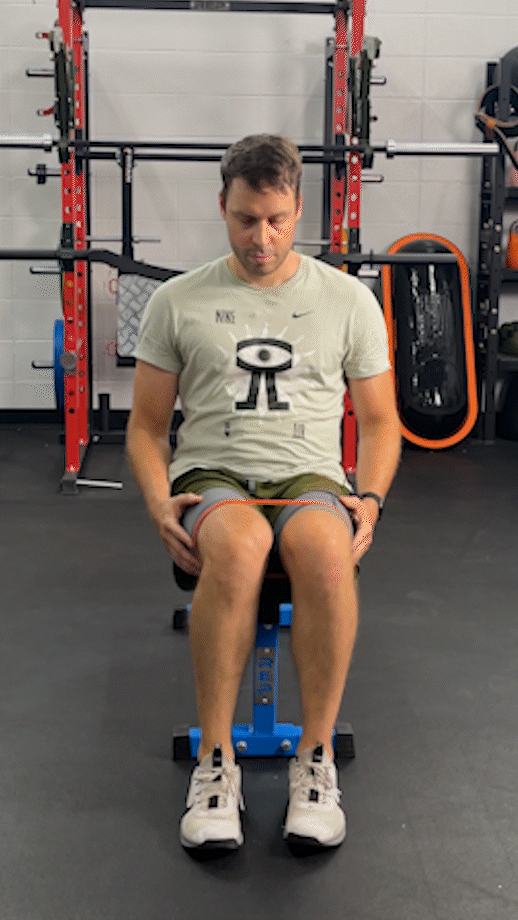
8. Good Mornings
Why it’s great: The good morning exercise, by itself, is an excellent bodyweight movement that trains the hip hinge movement, improves core strength, and enhances overall mobility. Add in a barbell, and you’ve got a lower body muscle builder, too!
How to do it:
- Start with your feet shoulder-width apart. If using a barbell, unrack it as though you’re about to back squat, keeping your back straight and core tight.
- Bring your hips back while lowering your chest toward the floor. Continue until your chest is nearly parallel with the floor.
- Slowly return to the standing position, bringing your hips forward at the end.
- Repeat as needed.
RELATED: The Good Morning Exercise
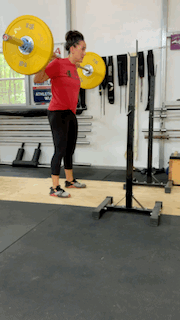
9. Romanian Deadlifts
Why it’s great: The RDL switches up the movement pattern of the conventional deadlift in order to increase activation of the hamstrings, enhancing their strength and flexibility.
How to do it:
- Grab a barbell, or pair of dumbbells, and hold them with your arms fully extended and your feet hip-width apart.
- Shift your hips back, lowering your chest and the weights toward the floor.
- Continue descending until you feel a stretch in your hamstrings.
- Return to the starting position by driving through your heels.
- Repeat as needed.
RELATED: RDL Workout
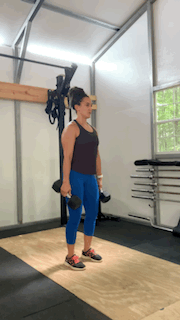
10. Single-Leg Deadlift
Why it’s great: A 2021 study7 published in the International Journal of Exercise Science found that the single-leg deadlift builds the glutes better than the conventional deadlift. Plus, you can perform it using a barbell, dumbbells, kettlebells, or even a med ball.
How to do it:
- Grab your weight and stand with your right leg off the ground.
- Hinge forward from your hips, bringing the weight toward the ground and your right leg behind you into the air. Your planted left leg should have a slight bend in the knee.
- Once you’re nearly parallel with the floor, slowly return to the starting position.
- Repeat as needed, then switch legs and repeat the set.
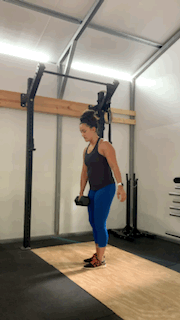
How Many Reps and Sets to Do During a Leg Workout
We’ve got the tools to build awesome lower body strength, but how do we put it all together into a comprehensive workout routine that, well, works?
According to a 2002 study8 published in the European Journal of Applied Physiology, it depends what you’re after. The study concluded that:
- A low rep scheme using heavy weights will build strength
- A high rep scheme using light weights will build endurance
- A moderate rep scheme using moderate weights promotes hypertrophy
So, what specifically do we mean here?
For strength gains, aim to complete two to six sets of only one to five reps. That might not seem like a lot, but you’ll want to be lifting somewhere around 80% of your one-rep max, so you’ll likely feel it after even the first set!
For muscular endurance, grab some lighter weights, about 40% your capabilities, and bang out between 15 and 20 reps for two or three sets. Although you’re working light, don’t rush. Take your time, prioritizing form and squeezing the contraction on each rep.
Now, for hypertrophy, you’ll want to go straight down the middle. We’re talking three to six sets of six to 12 reps using weights that are in the 60% to 75% range of your max weight.
For more specific advice, consider working with a coach, CPT, or other qualified fitness professional.
RELATED: How Many Reps To Build Muscle
FAQs: Lower-Body Workout
How many times per week should I work out legs?
There are so many muscle groups to target that once or twice a week for your legs should be more than sufficient. That way you’re leaving days for other splits, like a back and biceps or chest and triceps day, as well as a true rest day, too.
Can you squat every day?
Squatting every day is less likely to compound your gains and more likely to leave your lower body muscles in shambles.
We recommend leaving 24 to 48 hours in between training sessions that involve squats to allow proper muscle recovery.
If you’re really trying to get back to squatting sooner, studies show9 massage to be the most effective method for reducing delayed-onset muscle soreness and perceived fatigue.
Are squats bad for your back?
Squats, when done properly, are actually pretty good for your back, specifically your lower back since it receives the most activation during the movement.
Poor form, particularly poor form stemming from insufficient core strength, will increase the shear forces on the lumbar spine, however, and could contribute to or cause a back injury.
To avoid this, make sure you’re lifting a weight that allows you to complete the range of motion while maintaining perfect form. Swapping your back squat for the front squat, which places less strain on the lower back, is not a bad idea either.
How do I make a lower body workout plan?
The best lower body exercises, like the ones we’ve outlined above, are nothing without proper programming. We recommend selecting between four and eight of the exercises above and completing them in sequence using the rep schemes and number of sets that are conducive to your goals.
For a personalized plan, consider working with a personal trainer.
How can I build my lower body fast?
There are no shortcuts in fitness. Only by putting in the work, both in and out of the gym, can you enjoy the fruits of your labor.
To build your lower body fast, combine the above exercises into a program that supports your personal fitness goals. Supplement your success by eating right, drinking plenty of water, and getting enough sleep.
With hard work and dedication, you’ll soon find out firsthand what makes having incredible lower body strength such a worthy pursuit! Good luck, fitness fam!
References
1. Elzanie A, Borger J. Anatomy, Bony Pelvis and Lower Limb, Gluteus Maximus Muscle. In: StatPearls. Treasure Island (FL): StatPearls Publishing; April 1, 2023.
2. Bordoni B, Varacallo M. Anatomy, Bony Pelvis and Lower Limb: Thigh Quadriceps Muscle. In: StatPearls. Treasure Island (FL): StatPearls Publishing; May 8, 2023.
3. Rodgers CD, Raja A. Anatomy, Bony Pelvis and Lower Limb, Hamstring Muscle. In: StatPearls. Treasure Island (FL): StatPearls Publishing; April 1, 2023.
4. Binstead JT, Munjal A, Varacallo M. Anatomy, Bony Pelvis and Lower Limb: Calf. In: StatPearls. Treasure Island (FL): StatPearls Publishing; May 23, 2023.
5. Cazeau C, Stiglitz Y. Effects of gastrocnemius tightness on forefoot during gait. Foot Ankle Clin. 2014;19(4):649-657. doi:10.1016/j.fcl.2014.08.003
6.Gullett JC, Tillman MD, Gutierrez GM, Chow JW. A biomechanical comparison of back and front squats in healthy trained individuals. J Strength Cond Res. 2009;23(1):284-292. doi:10.1519/JSC.0b013e31818546bb
7. Diamant W, Geisler S, Havers T, Knicker A. Comparison of EMG Activity between Single-Leg Deadlift and Conventional Bilateral Deadlift in Trained Amateur Athletes – An Empirical Analysis. Int J Exerc Sci. 2021;14(1):187-201. Published 2021 Apr 1.
8. Campos GE, Luecke TJ, Wendeln HK, et al. Muscular adaptations in response to three different resistance-training regimens: specificity of repetition maximum training zones. Eur J Appl Physiol. 2002;88(1-2):50-60. doi:10.1007/s00421-002-0681-6
9. Dupuy O, Douzi W, Theurot D, Bosquet L, Dugué B. An Evidence-Based Approach for Choosing Post-exercise Recovery Techniques to Reduce Markers of Muscle Damage, Soreness, Fatigue, and Inflammation: A Systematic Review With Meta-Analysis. Front Physiol. 2018;9:403. Published 2018 Apr 26. doi:10.3389/fphys.2018.00403
Further reading

These wall exercises can be done anywhere and provide a total-body workout with no special equipment required. Read more

What is quadrobics? From how to do it to its potential benefits, learn more about the four-limbed fitness movement that’s making huge leaps in popularity. Read more

A CPT lays out the differences and similarities between a fitness ring and a fitness watch in our Oura Ring vs Apple Watch comparison. Read more

Not sure how to clean a barbell? This guide will help you knock the rust off. Read more

